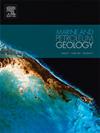Oceanic redox variations during the Cambrian Age 2–3 in the Yangtze Block of South China: Evidence from pyrite-based proxies
IF 3.7
2区 地球科学
Q1 GEOSCIENCES, MULTIDISCIPLINARY
引用次数: 0
Abstract
The early Cambrian marks a pivotal period in metazoan evolution and ocean oxygenation through Earth's history, with sedimentary sequences in the Yangtze Block of South China preserving key records about biological and environmental evolution. Although previous studies have focused on redox conditions in shelf, slope, and basin environments, their controls on pyrite sulfur isotope (δ34Spy) variations, and the influence of redox dynamics on biological activity within intraplatform basin remain unclear. This study presents results including diagnostic fossils, pyrite morphology, iron speciations, and δ34Spy from the shales of the early Cambrian Qiongzhusi Formation in well W207, which is located in an intraplatform basin of the Yantze Block. These data are integrated with previous datasets from eight sections spanning shelf, slope, and basin environments. Our results indicate that during the transgression at the Cambrian Age 2–3 boundary (∼524–520 Ma), mid-depth euxinic waters on the slope expanded into the intraplatform basin, as supported by most samples with FeHR/FeT > 0.38, Fepy/FeHR > 0.7, high MoEF/UEF ratio (mean 5.2) and small sizes of framboidal pyrite (6.41 ± 0.70 μm). In contrast, in the early Cambrian Age 3 (∼520–517 Ma), these geochemical proxies collectively suggest widespread shelf oxygenation, coinciding with occurrence of abundant animal fossils in the strata. The seawater oxygenation probably facilitated metazoan diversification during the Cambrian explosion within the intraplatform basin. Deep-water oxygenation together with emerging bioturbations on the shelf shifted the oxic-anoxic redox interface from bottom water into sediments, promoting the formation of pyrite with heavy δ34Spy values within seidments. Therefore, a spatial δ34Spy gradient is observed during early Cambrian Age 3, with higher δ34Spy values from the shallow shelf (more oxygen-rich) and deep basin (isotopically heavier sulfate in seawater) than those from middle-depth slope. The findings provide new insights into the redox landscape and its impact on biogeochemical cycling and metazoan evolution in the Yangtze Block during the early Cambrian.
华南扬子地块寒武纪-第三纪海洋氧化还原变化:来自黄铁矿的证据
早寒武纪是地球历史上后生动物演化和海洋氧合作用的关键时期,华南扬子地块的沉积序列保存了生物和环境演化的重要记录。虽然以往的研究主要集中在陆架、斜坡和盆地环境的氧化还原条件上,但它们对黄铁矿硫同位素(δ34Spy)变化的控制以及氧化还原动力学对平台内盆地生物活性的影响尚不清楚。本文介绍了扬子地块台内盆地W207井早寒武世筇竹寺组页岩的诊断化石、黄铁矿形态、铁形态和δ34Spy等研究成果。这些数据与以前的8个剖面的数据集相结合,包括陆架、斜坡和盆地环境。结果表明,在寒武纪2-3界(~ 524 ~ 520 Ma)海侵期间,斜坡上的中深含氧水体向台内盆地扩展,大部分FeHR/FeT >样品支持这一结论;0.38, Fepy/FeHR >;0.7, MoEF/UEF比高(平均5.2),草莓状黄铁矿尺寸小(6.41±0.70 μm)。相比之下,在早寒武纪3 (~ 520 ~ 517 Ma),这些地球化学指标共同表明陆架氧化作用广泛存在,与地层中大量动物化石的出现相吻合。在寒武纪大爆发期间,海水的氧化作用可能促进了地内盆地内后生动物的多样化。深水氧合作用和陆架上出现的生物扰动将底水的氧-缺氧氧化还原界面转移到沉积物中,促进沉积物中形成重δ34Spy值的黄铁矿。因此,早寒武世3期存在空间δ34Spy梯度,浅陆架(富氧)和深盆地(海水中硫酸盐同位素较重)的δ34Spy值高于中深斜坡。这些发现为揭示早寒武世扬子地块氧化还原景观及其对生物地球化学循环和后生动物演化的影响提供了新的认识。
本文章由计算机程序翻译,如有差异,请以英文原文为准。
求助全文
约1分钟内获得全文
求助全文
来源期刊

Marine and Petroleum Geology
地学-地球科学综合
CiteScore
8.80
自引率
14.30%
发文量
475
审稿时长
63 days
期刊介绍:
Marine and Petroleum Geology is the pre-eminent international forum for the exchange of multidisciplinary concepts, interpretations and techniques for all concerned with marine and petroleum geology in industry, government and academia. Rapid bimonthly publication allows early communications of papers or short communications to the geoscience community.
Marine and Petroleum Geology is essential reading for geologists, geophysicists and explorationists in industry, government and academia working in the following areas: marine geology; basin analysis and evaluation; organic geochemistry; reserve/resource estimation; seismic stratigraphy; thermal models of basic evolution; sedimentary geology; continental margins; geophysical interpretation; structural geology/tectonics; formation evaluation techniques; well logging.
 求助内容:
求助内容: 应助结果提醒方式:
应助结果提醒方式:


